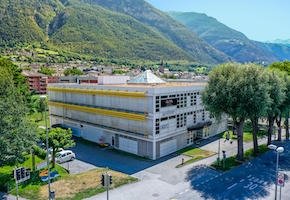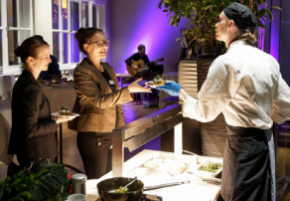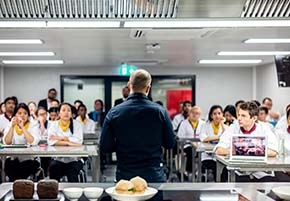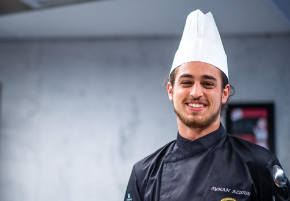- About
- Programs
- Campus Life
- Career Services
- Admissions
- News & Events
- Alumni
Cafe and Bakery: Catering
Observation of a breadmaking class
The ambiance is reminiscent of an operating room in a hospital, with the sound of machines humming, alarms beeping, equipment whirring, and buttons switching between red and green. Brief conversations echo through the air.
"Chef, my dough is reaching 24 degrees."
"We need to stop it."
"The yeast is ready, be careful. "
"How many minutes are left for the gluten-free bread dough?"
“4 minutes.”
"Chef, our dough is still at 19 degrees."
"Keep mixing."
"Yes, at a higher speed. "
There is a certain degree of nervousness in the students’ voices, but their Chef maintains a sense of calm and reassurance.
We are in the kitchen for the lesson ‘Cafe and Bakery: Catering’. Four pastry & chocolate arts students from three countries are in today’s breadmaking class. In a small group, the students benefit from the full attention of Chef Yann Muriset and an equal opportunity to make their own bread.
Students work in pairs preparing ingredients for the first dough.
Today’s topic is Healthy, gluten free, and Mediterranean breads. The practical and theory agenda for the day is as follows:
- Slow and fast fermentation – Theory
- Sourdough starter – Theory
- Bassinage technique – Theory
- Focaccia bread dough
- Small lemon bread dough
- Chocolate bread dough
- Whole wheat bread dough
- Multis seeds and dried fruits bread dough
- Hazelnut gluten free bread dough
- Introduction of the sourdough bread
- Herbs sourdough bread dough
It is serious work, standing from 10am to 5pm, with a 30-minute lunch break, preparing seven doughs and baking two bread. The one-chef and four-student crew has a lot to accomplish.
Chef instructor Yann does a demonstration
Did you ever wonder what the recipes are like at a professional culinary school?
The answer is: not amusing. The recipes are long Word documents, precise and detailed with red highlighted text throughout. For example:
- “Portion size: 285g…”
That’s right, not 300g, not 280g, but 285g. - “Portion size: …16cm diameter x 2cm high rings”.
Yes, did you do well in your geometry class? - “Water first portion at 4°C”.
First portion? Yes, there is the second portion of water later.
The recipe also includes a section of 'Chef's Tips', which are the Chef's secrets that you won't find in a commercial cookbook.
The tips also sound overwhelmingly technical. For example, "Longer knead time results in higher dough temperature".
As the students follow along the recipe, Chef instructor poses questions:
"Why do you need to rinse the seeds and dried fruits? To remove any residual sand!"
"Why do we trim the ends of the figs? Because they are too tough to eat!"
Though the recipes are precise, there is an art to interpreting the recipe to the actual environment and students need to learn to improvise accordingly.
As the weather is quite hot today, let’s use 20g of yeast, instead of 30g.
Students need to consider factors like room temperature, humidity, the feel of the dough and its color. These skills are learned with an experienced Chef at their side.
Students touch the surface of the dough to remember the feel of it
As the class progresses, we see that the students are quietly adopting the professional habits they are being taught, like cleaning the scales after every measurement or wiping down the kitchen worktop after every use.
They're also experimenting with the new techniques from the lesson such as:
- Feed sourdough starter
- Knead dough with mixer
- Mix dough by hand (sourdough bread)
- Check dough temperature after kneading
- Dough - bulk fermentation
- Dough - fast fermentation (bake on same day)
- Dough - slow fermentation (leave overnight, bake following day)
- Cutting, shaping, rolling, proofing and baking
- Focaccia filling with dried ham, rucola and parmesan cheese
Bambi is the name of the Sourdough starter prepared by the students
Though it is a long process, time passes quickly in the kitchen. It is a very rewarding and heartwarming moment when the students take their freshly baked bread out of the oven and serve it at the counter.
The delicious and irresistible aroma wafted far from the kitchen, attracting students and staff like little birds searching for a fresh bite of the still-warm bread.
We hope you enjoyed this bread making experience. As a thank you for reading, we'd like to offer you a small gift. Click here to access one of the real recipes used in this class. Good luck!
Bake bread with us! Download our brochure to learn about the Pastry & Chocolate Arts Diploma and other programs at CAAS.






















